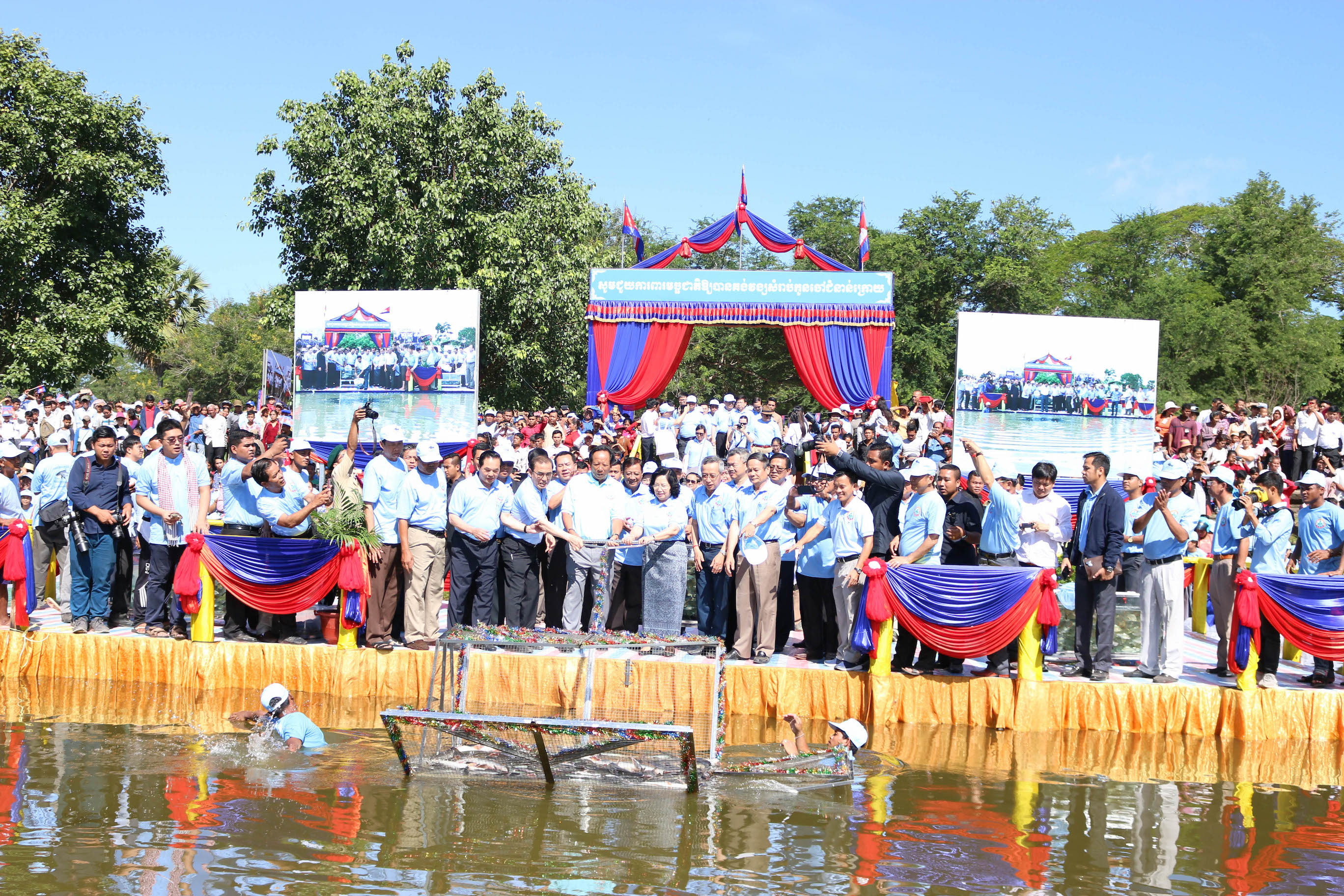
Siem Reap: Fish play an important role in Cambodia’s society and economy. About 80 percent of the protein consumed by Cambodians is from freshwater fish caught in the Mekong River, Tonle Sap, Tonle Sap Lake and streams, etc. Every year, on July 1, Cambodia celebrates National Fish Day in Lakes and Reservoirs.
This year the National Fish Day was held in Kaksin and Kouteuk surrounding Angkor Wat, in Tropaing Saing Village, Sangkat Kork Chork, Siem Reap, Siem Reap Province, in front of Angkor Wat. The event was attended by Samdech Tea Banh, Minister of Defense, Minister of Agriculture, Forestry and Fisheries, Government Officers, Citizens and Students more than 500 people.
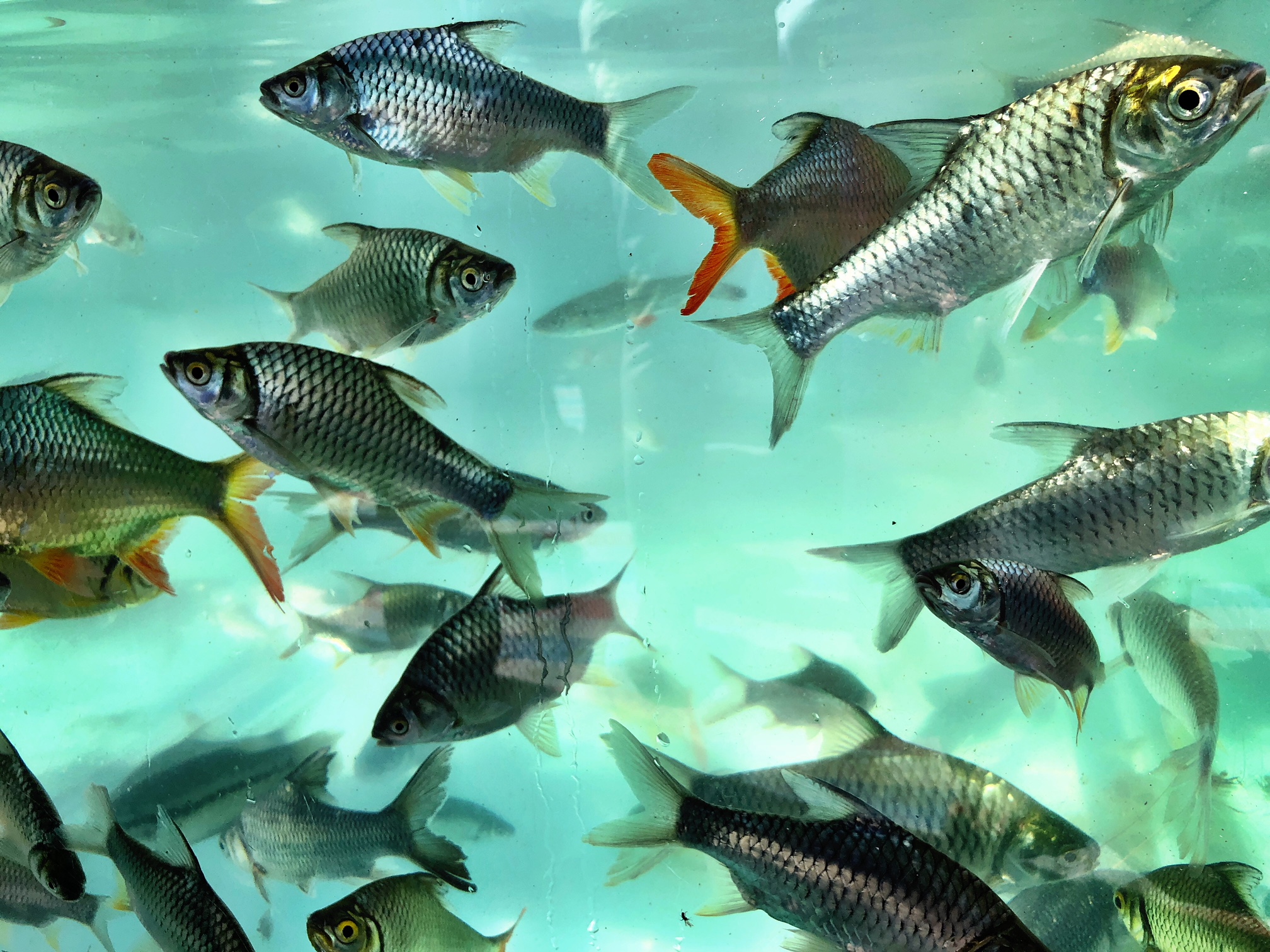
More than one million fish were released, such as Silver barb (Barbonymus gonionotus), Toli shad (Tenualosa toli), Red tailed tinfoil (Barbonymus altus), Striped catfish (Pangasianodon hypothamus), Snakeskin gourami (Trichopodus pectoralis) and Giant barb (Catlocarpio siamesis), turtles and frogs. The Minister of Agriculture, Forestry and Fisheries, H.E. Veng Sakhorn, is optimistic that these fish will grow to other areas along the Baray system in the Angkor area and can reach other fishing grounds that can meet the needs of the general population.
In the report of H.E. Veng Sakhon on fisheries in past year (2017), 3,925 fishery crimes were suppressed, which destroyed more than 3,000 sets of illegal fishing gear, punishment was issued in more than a hundred cases, and sent to court more than 86 cases. In 2017, the catch reached to more than 800,000 tons, up more than 6%, especially from aquaculture. He added that capture fisheries, freshwater and marine fisheries totaled over 600,000 tons, of which freshwater products were implemented more than 500,000 tons, increasing over 3%, and marine fishing products were more than 100 thousand tons.
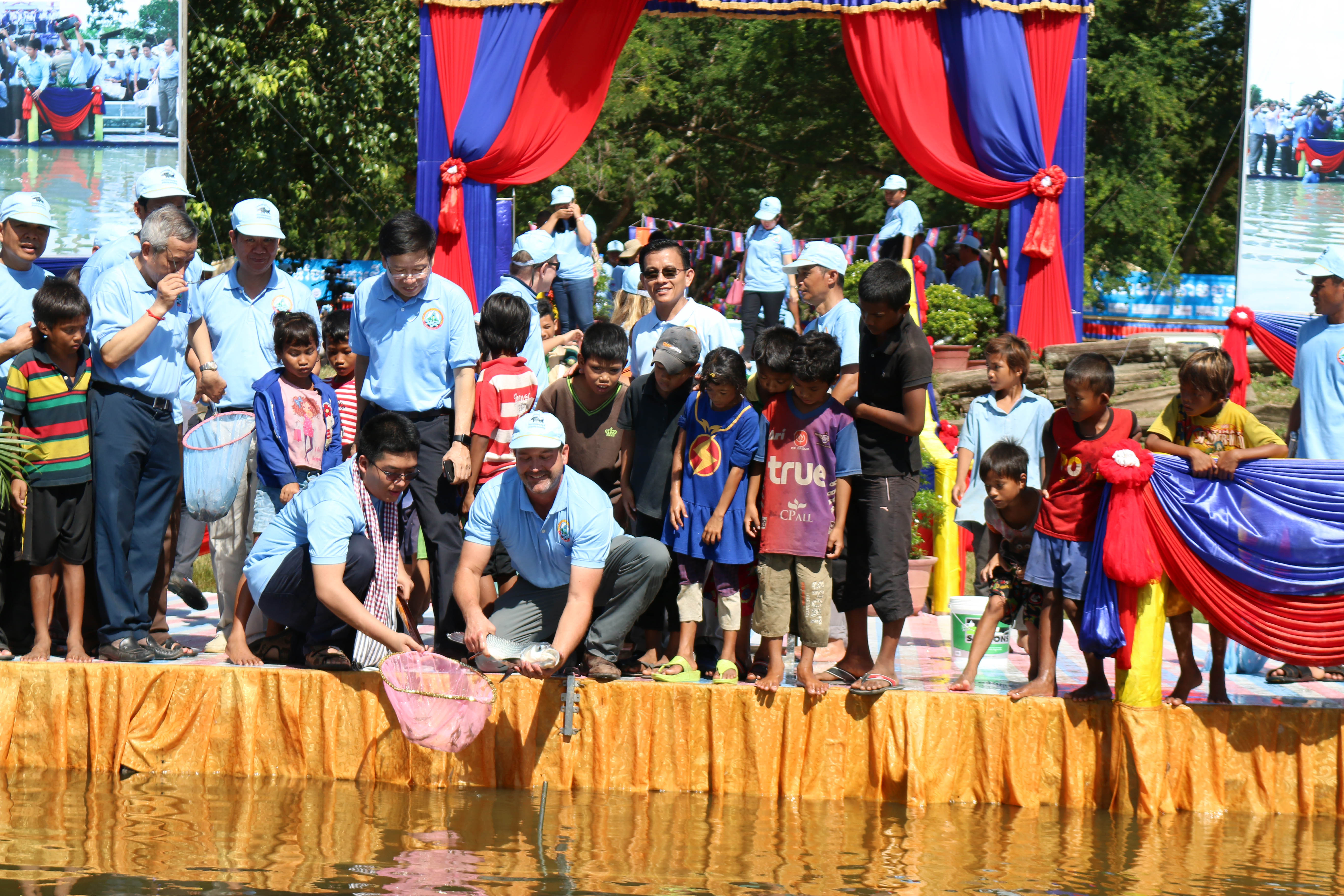
Dr. Zeb Hogan, the principal investigator of the USAID-funded Wonders of the Mekong Project and a research professor at the Global Water Center at the University of Nevada in the United States and a National Geographic Explorer and the U.N. Convention on Migratory Species COP-Appointed Scientific Councilor for Fish, said, “Fish are one of Cambodia’s most important natural resources. National Fish Day (July 1) raises awareness about the importance of fish to Cambodian livelihoods, culture, and natural heritage. In Cambodia, there is an important connection between fish, water, and people. On National Fish Day we recognize and celebrate that connection. It is important to maintain the connection between people and fish in Cambodia so that people work to promote sustainable fishing practices and keep Cambodia’s river and lakes healthy and productive.”
He added that, “In Cambodia, nicknamed the Kingdom of Wonder, fish, the Tonle Sap Lake, the Mekong River, flooded forest and rice fields are the true “wonders” of this region. You can see the importance of fish and water everywhere in Cambodia. In restaurants everyone eats grilled fish and fish soup, at home people eat pra hok, millions of Cambodians rely on fish and fishing for income and food. On the Tonle Sap Lake, entire communities live in floating houses, and raise fish in cages below their homes. An incredible and amazing diversity of fish live in Cambodia, and fish have been important to Khmer people for thousands of years. Fish are carved on the walls of Cambodia’s most famous temples and Cambodia’s money is named after one of the country’s most famous fish – trey riel Siamese mud carp (Gymnostomus siamensis).”
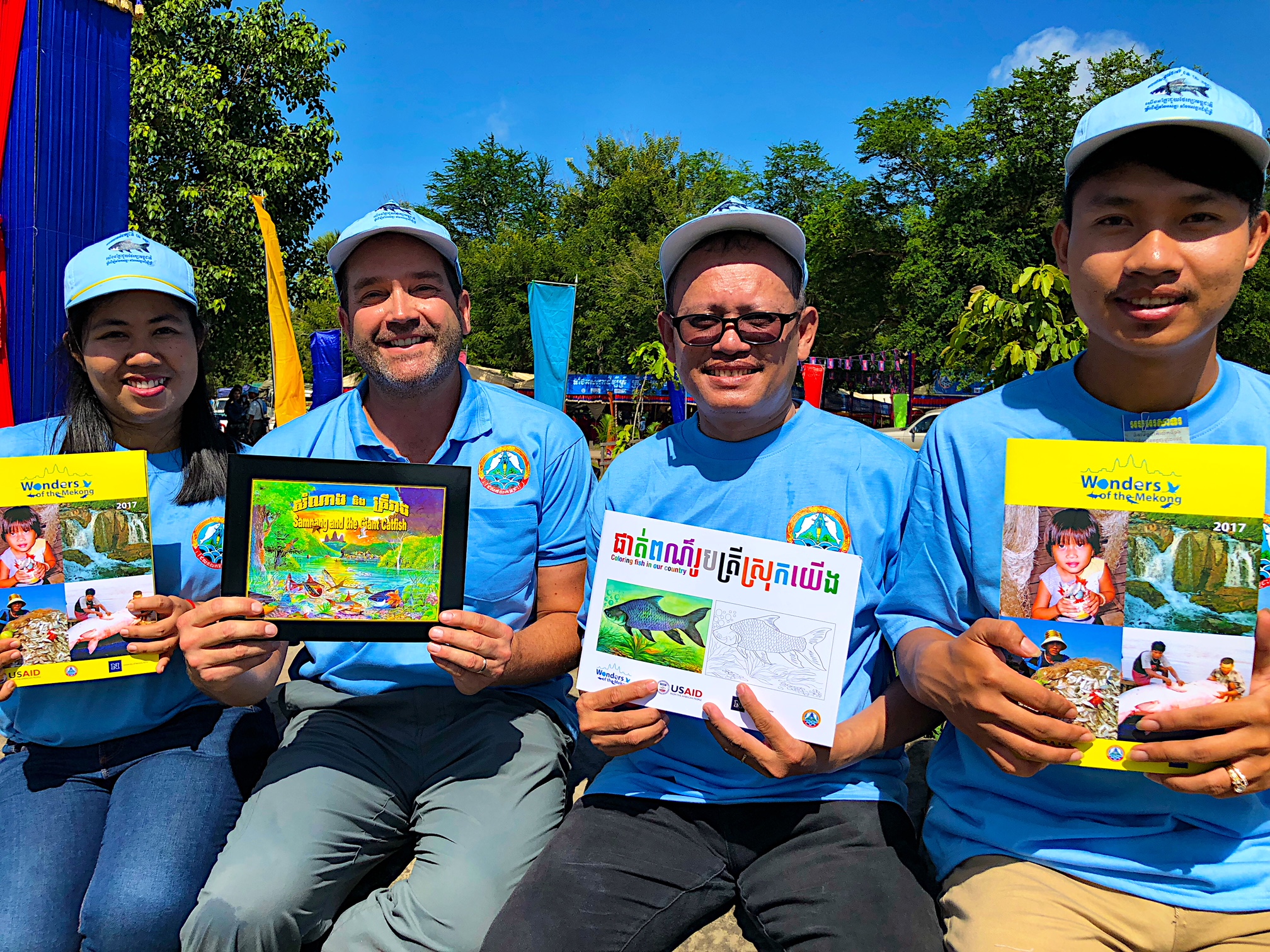
To contribute to the celebration of this meaningful day, Wonders of the Mekong project brought juveniles of many fish species, especially the endangered fish species, such as the Giant Barb (Catlocarpio siamensis), Striped catfish (Pangasianodon hypothamus), Giant pangasius (Pangasius sanitwongsei), Isok barb (Probarbus jullieni) and other mixed fish species, which the project has reared in the fish breeding station and research site in Peam Ro district, Prey Veng province in Cambodia.
This is story is by Chhut Chheana of the USAID-funded Wonders of the Mekong Program.
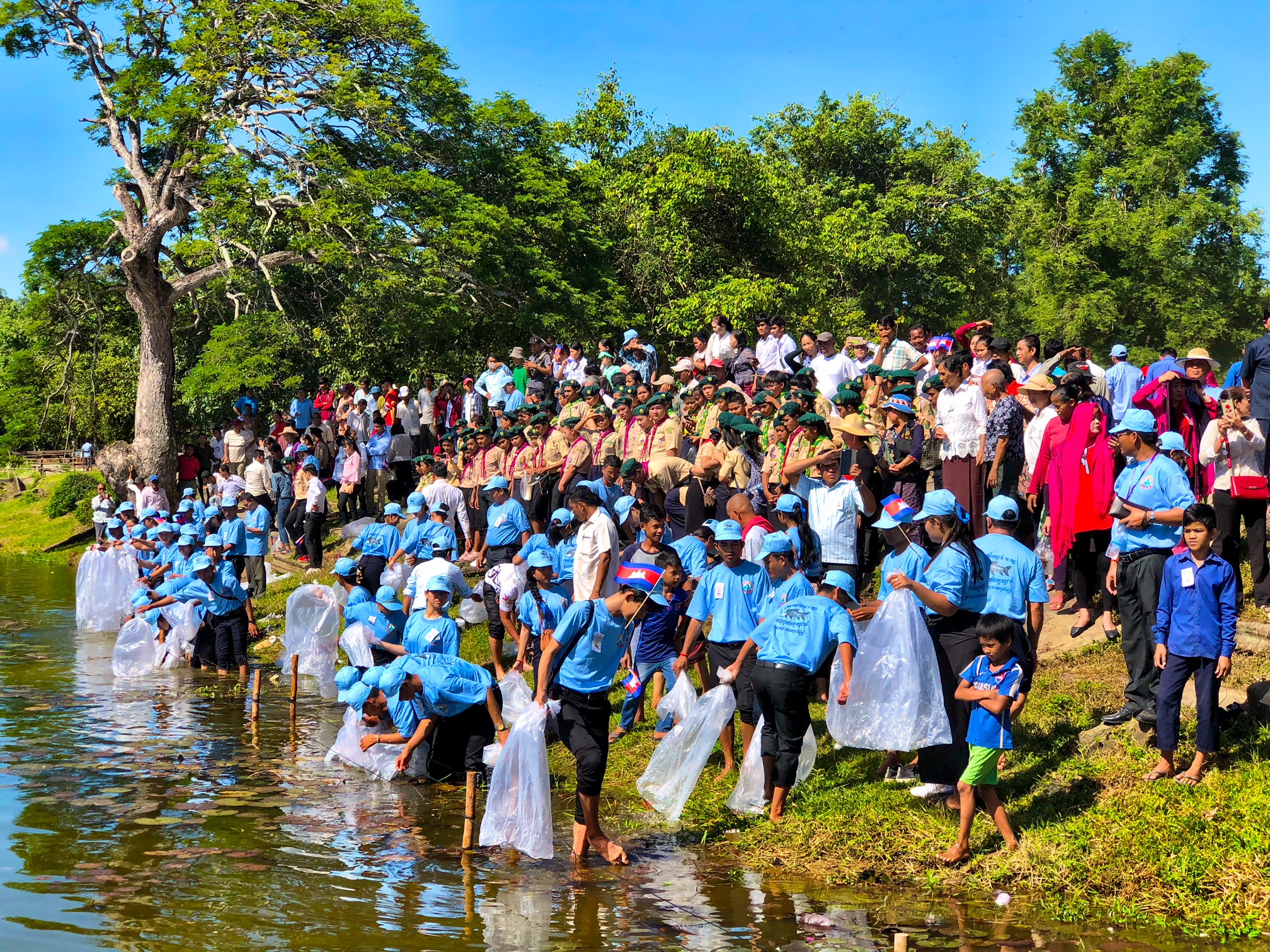
សៀមរាបៈ មច្ឆជាតិ បានដើរតួនាទីដ៏សំខាន់មួយនៅក្នុងសង្គម និងសេដ្ឋកិច្ចរបស់ប្រទេសកម្ពុជា។ ប្រូតេអ៊ីនចំណីអាហារប្រមាណ ៨០ ភាគរយ ដែលប្រជាជនកម្ពុជាទទួលបាន គឺពីត្រីទឹកសាប ដែលចាប់បាននៅក្នុងទន្លេមេគង្គ ទន្លេសាប បឹងទន្លេសាប អូរ ស្ទឹង បឹងបួរ ត្រពាំងជាដើម។ ជារៀងរាល់ឆ្នាំ នៅថ្ងៃទី១ ខែកក្កដា ប្រទេសកម្ពុជា បានប្រារព្ធទិវាមច្ឆជាតិ នៅបឹងធំៗ និងអាងស្តុកទឹក។
ទិវាមច្ឆជាតិក្នុងឆ្នាំ២០១៨នេះ ត្រូវបានប្រារព្វធ្វើឡើងនៅក្នុងកសិណអង្គវត្ត ភូមិត្រពាំងសេះ សង្កាត់គោកចក ក្រុងសៀមរាប ខេត្តសៀមរាប ធ្វើឡើងនៅមុខប្រាសាទអង្គរវត្ត ក្រោមវត្តមានចូលរួមពី សម្តេច ទៀ បាញ់ រដ្ឋមន្ត្រីក្រសួងការពារជាតិ រដ្ឋមន្ត្រីក្រសួងកសិកម្ម រុក្ខាប្រមាញ់ និងនេសាទ អភិបាលខេត្ត ព្រមទាំងមន្ត្រីរាជការ ប្រធានមន្ទីរ ប្រជាពលរដ្ឋ និងសិស្សានុសិស្សសរុបប្រមាណជាង ៥០០នាក់៕
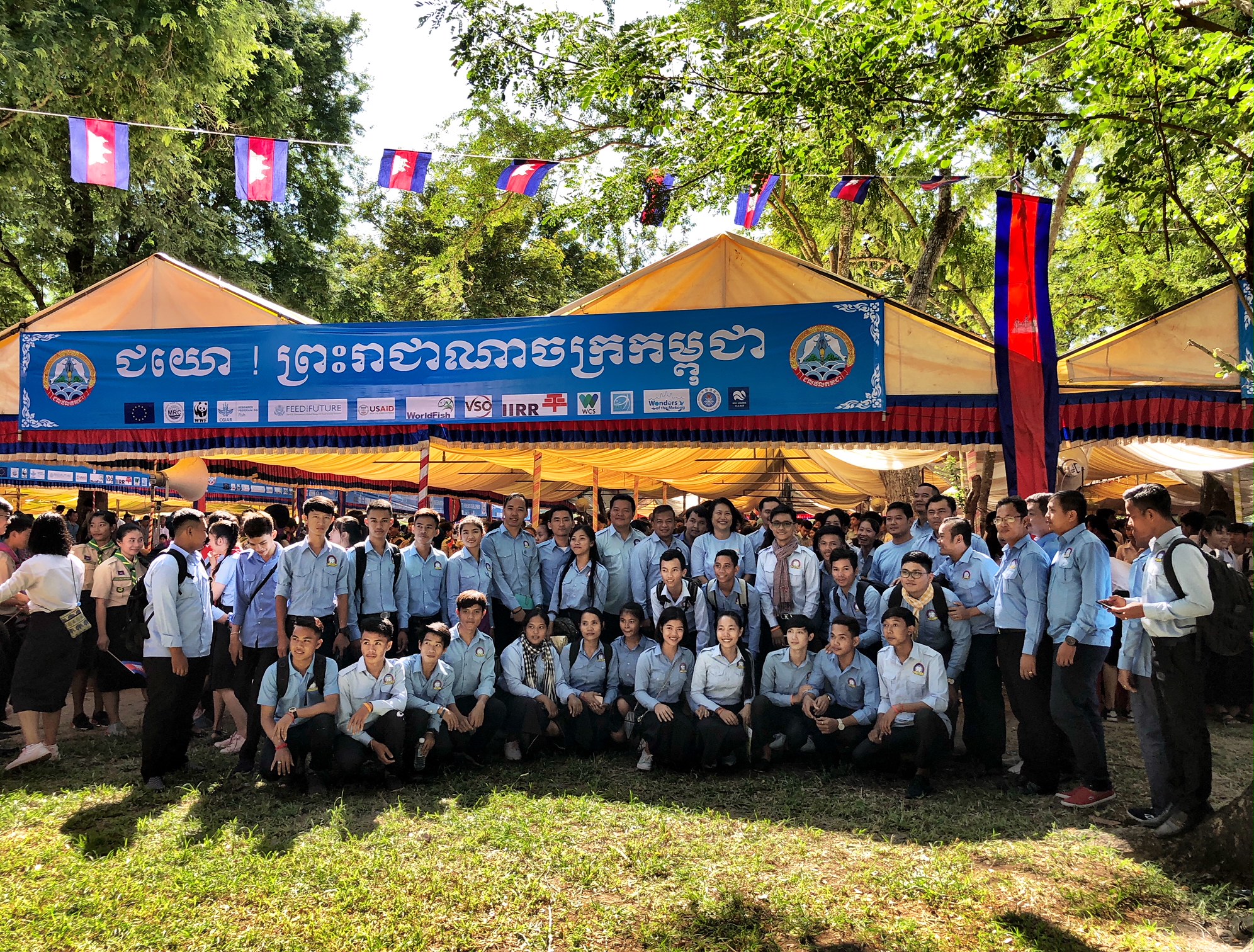
កូនត្រីជាង១លានក្បាល ដែលត្រូវបានព្រលែងនៅពេលនេះមានដូចជា ត្រីឆ្ពិន Silver barb (Barbonymus gonionotus) ត្រីព្រលូង Toli shad (Tenualosa toli) ត្រីកាហែ Red tailed tinfoil (Barbonymus altus) ត្រីប្រា Striped catfish (Pangasianodon hypothalamus) ត្រីកន្ធរ Snakeskin gourami (Trichopodus pectoralis) និងត្រីគល់រាំង Giant barb (Catlocarpio siamensis) អណ្ដើក កន្ធាយ និងកង្កែប។ល។ រដ្ឋមន្ត្រីក្រសួងកសិកម្ម រុក្ខាប្រមាញ់ និងនេសាទ ឯកឧត្តម វេង សាខុន មានសុទិដ្ឋិនិយមថា ត្រីទាំងនេះនឹងមានការលូតលាស់រីកសាយភាយទៅដល់តំបន់ផ្សេងៗទៀតតាមប្រព័ន្ធបារាយណ៍ក្នុងតំបន់អង្គរ និងអាចចរាចរចូលដល់ដែននេសាទដទៃទៀត ដែលអាចបំពេញសេចក្តីត្រូវការរបស់ប្រជាពលរដ្ឋទូទៅ។
ក្នុងរបាយការណ៍របស់រដ្ឋមន្ដ្រី វេង សាខុន ទាក់ទងនឹងជលផល ក្នុងឆ្នាំ២០១៧កន្លងទៅ បទល្មើសជលផលមានចំនួន ៣,៩២៥ករណី ត្រូវបានបង្ក្រាប ក្នុងនោះបានបំផ្លាញចោលវត្ថុតាងចំនួន ជាង៣ពាន់ករណី ពិន័យអន្ដរការណ៍ជាងមួយរយករណី និងបញ្ជូនទៅតុលាការចំនួន ៨៦ករណី។ ចំណែកផលនេសាទវិញ ឆ្នាំ២០១៧ ផលនេសាទសរុបសម្រេចបានចំនួនជាង ជាង៨០០ពាន់តោន កើនជាង៦ភាគរយ ពិសេសកំណើនពីវារីវប្បកម្ម។ ឯកឧត្តមបានបន្ថែមថា៖ «ផលនេសាទចាប់ពីធម្មជាតិសរុបទាំងទឹកសាប និងសមុទ្រសម្រេចបានប្រមាណ ជាង៦០០ពាន់តោន ក្នុងនោះផលទឹកសាបអនុវត្តបានចំនួនជាង ៥០០ពាន់តោន កើនឡើងប្រមាណជាង ៣ភាគរយ និងផលនេសាទសមុទ្រអនុវត្តបានជាង ១០០ពាន់តោន»។
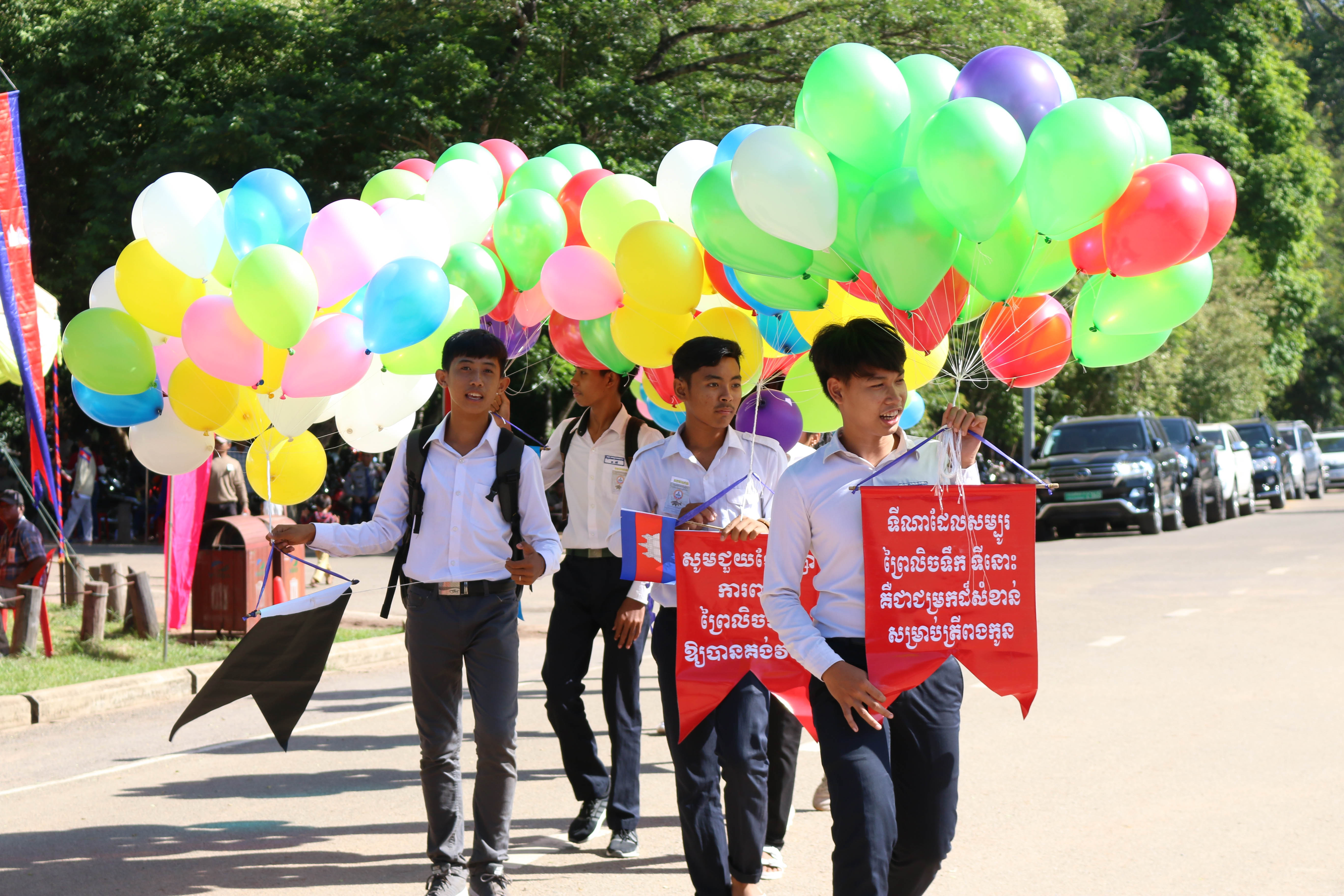
បណ្ឌិត ហ្សេប ហូហ្គេន ប្រធានគម្រោង អច្ឆរិយភាពនៃទន្លេមេគង្គ ដែលជាគម្រោងទទួលបានការឧបត្ថម្ភមូលនិធិដោយទីភ្នាក់ងារ USAID និងជាសាស្ត្រាចារ្យស្រាវជ្រាវនៅមជ្ឈមណ្ឌលទឹក សកល នៃសាកលវិទ្យាល័យណេវ៉ាដានៅសហរដ្ឋអាមេរិក និងជាអ្នករុករក ភូមិសាស្រ្តជាតិ National Geographic Explorer និងត្រូវបានតែងតាំងជា ក្រុមប្រឹក្សាវិទ្យាសាស្រ្ត របស់អង្គការសហប្រជាជាតិ ស្តីពីការធ្វើចរាចររបស់ត្រី COP បានមានប្រសាសន៍ថា៖«
ត្រីគឺជាប្រភពធនធានធម្មជាតិដ៏សំខាន់បំផុត របស់ប្រទេសកម្ពុជា។ ការប្រារព្វទិវាមច្ឆជាតិនេះឡើង គឺដើម្បីលើកកម្ពស់ការយល់ដឹង អំពីសារៈសំខាន់នៃត្រីចំពោះជីវភាពរស់នៅ វប្បធម៌ និងកេរដំណែលធម្មជាតិរបស់កម្ពុជា។ នៅកម្ពុជា ទំនាក់ទំនងរវាង ត្រី ទឹក និងប្រជាជនគឺមានសារៈសំខាន់ណាស់។ នៅក្នុងទិវាមច្ឆជាតិនេះ យើងទទួលស្គាល់ និងអបអរសាទទំនាក់ទំនងនេះ។ វាជាការសំខាន់ណាស់ ដើម្បីរក្សាទំនាក់ទំនងរវាងមនុស្ស និងត្រីនៅក្នុងប្រទេសកម្ពុជា ដើម្បីឱ្យប្រជាជនលើកកម្ពស់ ការអនុវត្តនេសាទប្រកបដោយនិរន្តរភាព និងរក្សាឱ្យទន្លេនិងបឹងនៅកម្ពុជា មានសុខភាពល្អ និងផលិតភាព»។
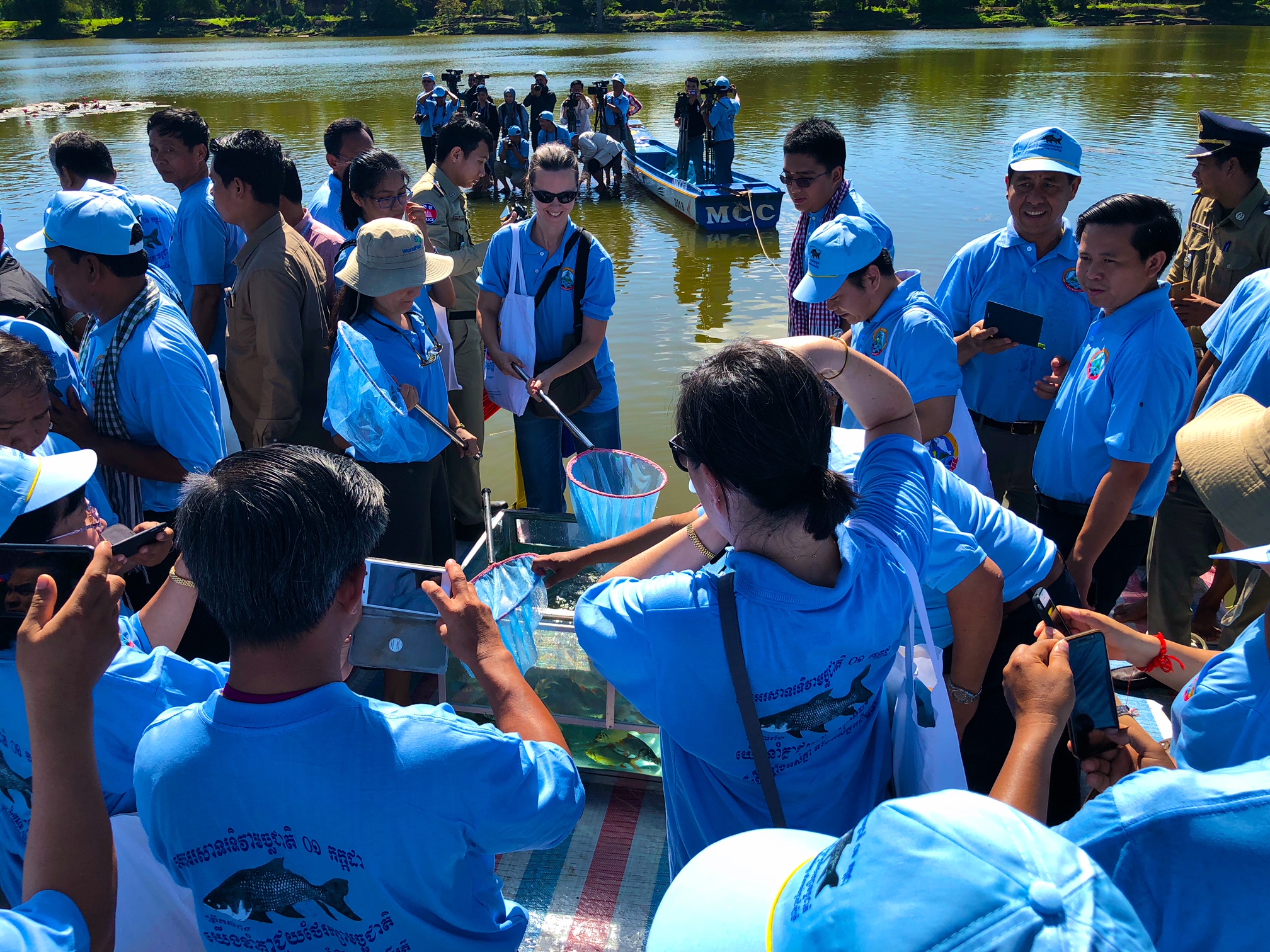
លោកបណ្ឌិត ហ្សេប ហូហ្គេន មានប្រសាសន៍បន្តទៀតថា៖«នៅក្នុងប្រទេសកម្ពុជា ដែលមានរហស្សនាមថា ព្រះរាជាណាចក្រអច្ឆរិយៈ ត្រី បឹងទន្លេសាប ទន្លេមេគង្គ បានជន់លិចព្រៃលិចទឹក និងវាលស្រែ គឺជា«អច្ឆរិយៈ» ដ៏ពិតប្រាកដនៃតំបន់នេះ។ អ្នកអាចឃើញសារៈសំខាន់នៃត្រី និងទឹក នៅគ្រប់ទីកន្លែងនៅក្នុងប្រទេសកម្ពុជា។ នៅក្នុងភោជនីយដ្ឋានគ្រប់ៗ គ្នាបរិភោគត្រីអាំង និងសម្លត្រី នៅតាមគេហដ្ឋាន ប្រជាជនកម្ពុជារាប់លាននាក់ ពឹងផ្អែកលើត្រី ប្រាក់ចំណូលពីការនេសាទត្រី និងម្ហូបអាហារ។ នៅបឹងទន្លេសាប សហគមន៍ទាំងមូល រស់នៅក្នុងផ្ទះបណ្តែតទឹក និងចិញ្ចឹមត្រីនៅក្នុងទ្រុងនៅខាងក្រោមផ្ទះរបស់ពួកគេ។ ត្រីសម្បូរបែបមិនគួរឱ្យជឿ និងអស្ចារ្យ រស់នៅក្នុងប្រទេសកម្ពុជា ហើយត្រីមានសារៈសំខាន់ចំពោះប្រជាជនខ្មែរតាំងពីរាប់ពាន់ឆ្នាំកន្លងមកហើយ។ ត្រីត្រូវបានឆ្លាក់នៅលើជញ្ជាំងនៃប្រាសាទដ៏ល្បីល្បាញបំផុតរបស់ប្រទេសកម្ពុជា ហើយប្រាក់របស់កម្ពុជា ត្រូវបានដាក់ឈ្មោះតាមត្រីមួយប្រភេទក្នុងចំណោមត្រីដ៏ល្បីល្បាញបំផុតរបស់ប្រទេសនេះគឺត្រីរៀល Siamese mud carp (Gymnostomus siamensis) ។
គួរបញ្ជាក់ថា ដើម្បីរួមចំណែក អបអរសាទរទិវាដ៏មានអត្ថន័យនេះ គម្រោងអច្ឆរិយភាពនៃទន្លេមេគង្គ បាននាំកូនត្រីជាច្រើនប្រភេទ ជាពិសេសត្រីដែលជិតផុតពូជ ដូចជាកូនត្រីគល់រាំង Giant barb (Catlocarpio siamensis) កូនត្រីប្រាធំ Striped catfish (Pangasianodon hypothalamus) កូនត្រីពោព្រុយ Giant pangasius (Pangasius sanitwongsei) កូនត្រីត្រសក់ Isok barb (Probarbus jullieni) ព្រមទាំងកូនត្រីចម្រុះ ផ្សេងៗទៀតផងដែរ ដែលគម្រោងបានដាក់បំប៉នឲ្យធំនៅស្ថានីយ៍ស្រាវជ្រាវ និងផលិតកូនត្រីពូជបាទី ស្រុកពាមរក៍ ខេត្តព្រៃវែង ដើម្បីចូលរួមអបអរទិវាមច្ឆជាតិនេះផង។